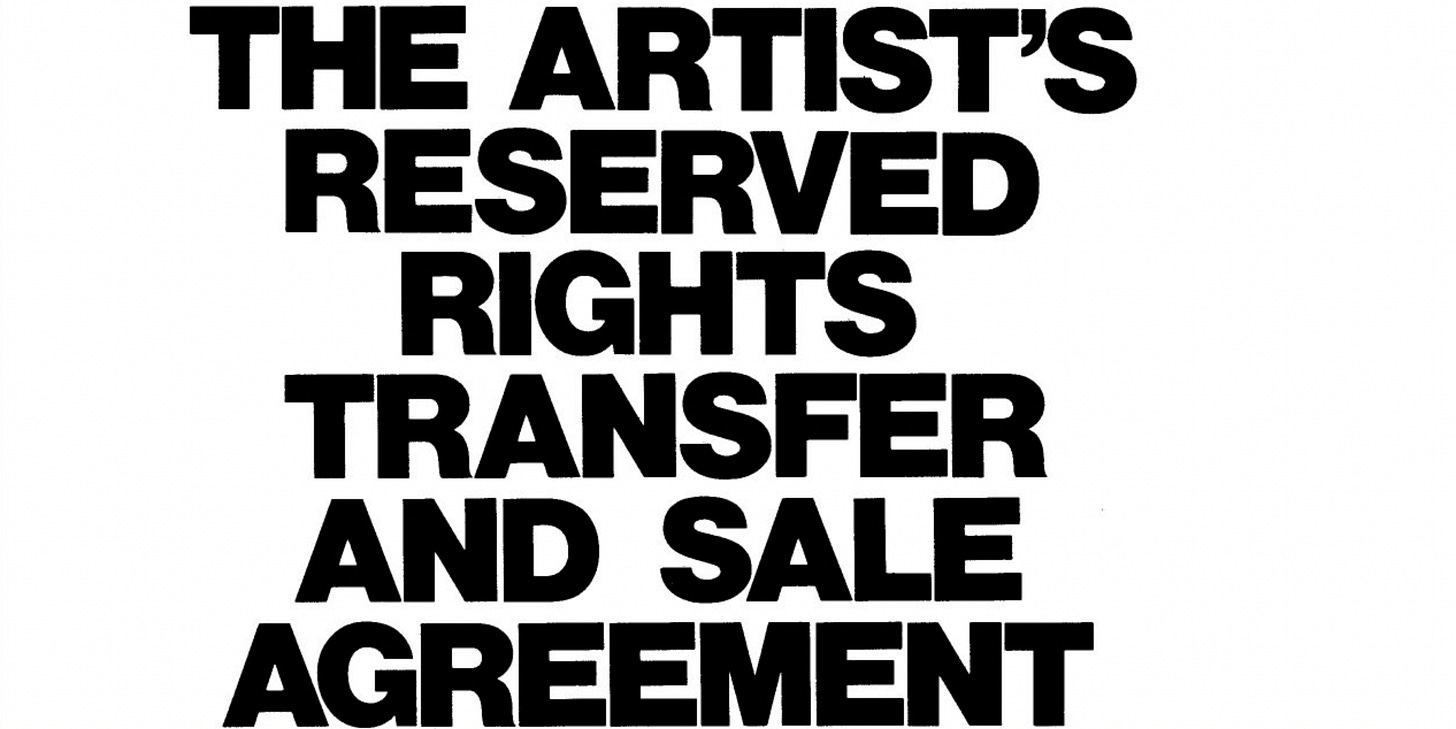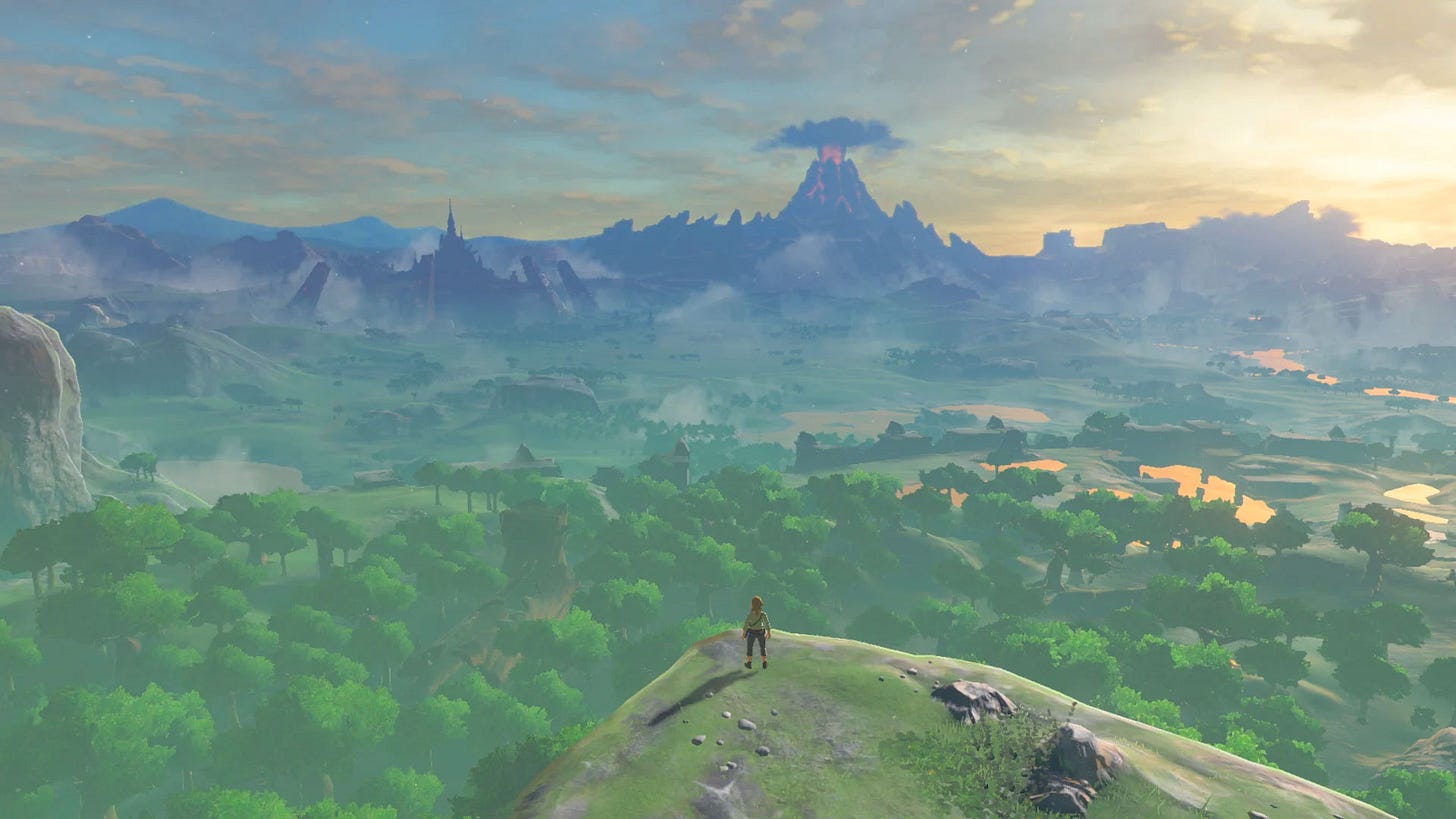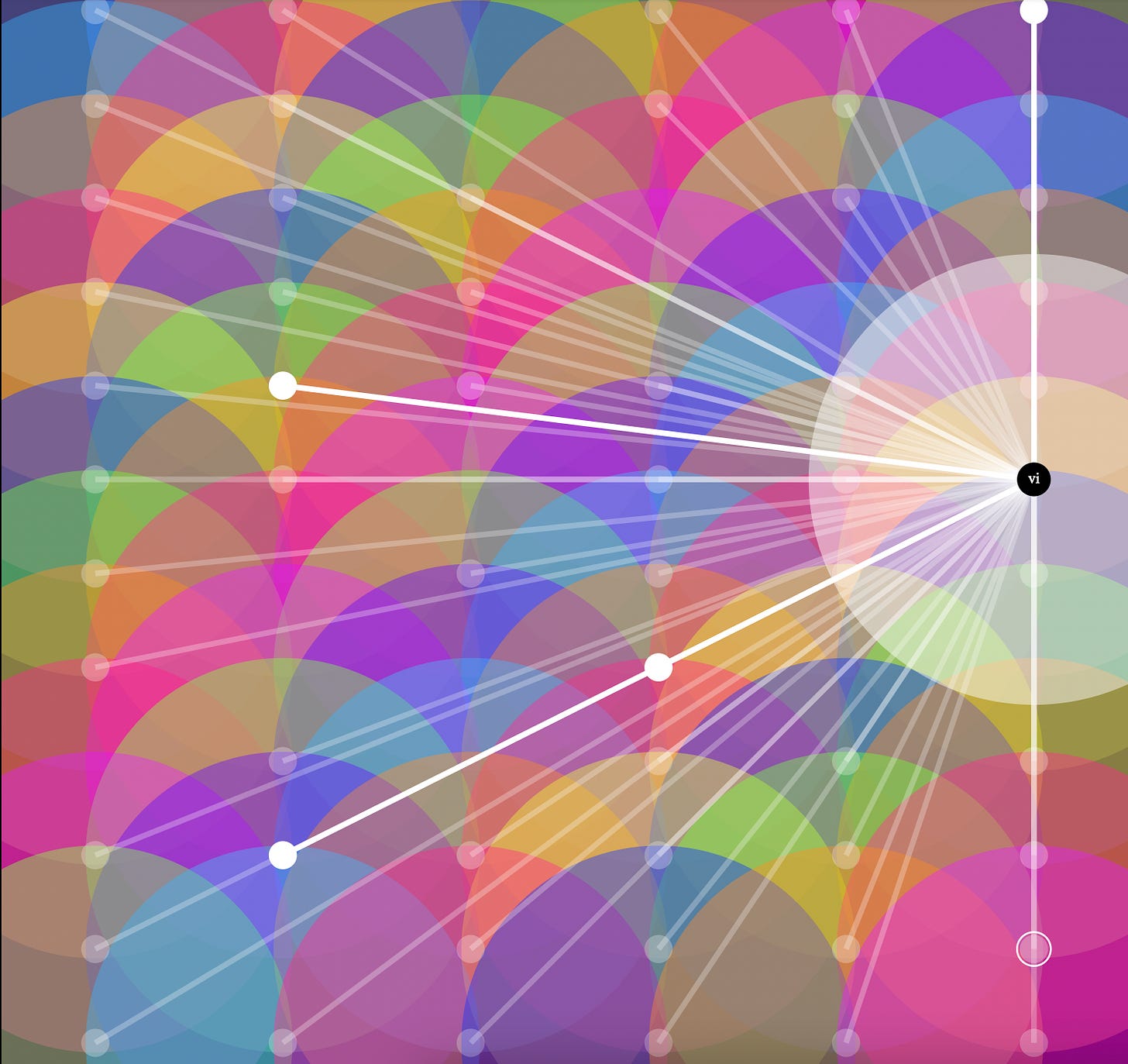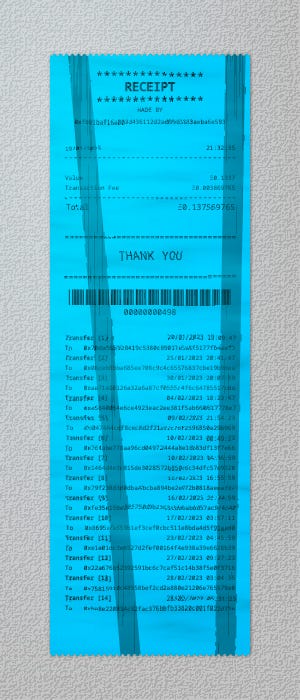Why NFT Royalties Matter
Also: Walking Zelda, Creativity from Presets, and Crypto-Social Aesthetics
The NFT marketplaces in a race to the bottom on fees, has meant that keeping support of secondary sale royalties at the social layer is slowly disappearing. What I enjoy about the article is that also tells more about the history of royalties in art in general (pre-NFT).
From early attempts in the 19th century to enshrine legal innovations in the 1970’s by Seth Siegelaub & Robert Projanksy:
In 1971, conceptual artist Seth Siegelaub and lawyer Robert Projansky tried to realize that demand by creating The Artist’s Reserved Rights Transfer and Sale Agreement or “Artist’s Contract,” which sought to create contractual resale royalties. Several artists used the Contract to sell their work, including Hans Haacke and Adrian Piper, but it was always a fool’s errand because the contractual royalties it sought to create were largely unenforceable. Sure, artists can sue their collectors for reneging on royalties, but it’s usually unwise to bite the hand that feeds you.
In the context of my project, “This Artwork Is Always On Sale”, showcasing a smart contract enforced royalties system that changes how NFTs are owned, there’s been additional articles that give great history and critique on attempting to change it.
The first is by Charlotte Kent on ArtNet where she documents efforts by Yasuo Kuniyoshi:
Kuniyoshi worked strenuously to avoid political language like the word “union” at a time when the nation already interpreted socialist tendencies among artists as inherently un-American. He gathered an impressive roster of 160 established and emerging artists including Jacob Lawrence, Alice Neel, Louise Nevelson, Isamu Noguchi, David Smith, and Charles Sheeler as founding members. A select group developed the initial 15-point program, which included such wide-ranging concerns as an emergency welfare fund for artists, a group health insurance plan, artists’ rights surrounding televised work, museum board representation, the desire to cultivate state and federal art projects, rental fees for exhibited work, and more.
It was an impressive effort, but even famous members like Grace Hartigan, Frank Stella, and the de Koonings could not leverage their celebrity to get the rights the group sought. Internal disputes eventually led to a split within the AEA. Nevelson served as the last national president from 1963 to 1965. (New York’s Artists Equity Association now carries the mantle, offering workshops and a members’ gallery on the Lower East Side.)
The second talks generally about where royalties should go by Martin Zeilinger:
We can see this attitude reflected in the recent trend for some NFT marketplaces to abandon equitable royalty schemes in order to make trading more attractive (read: profitable) for users. Certainly, such a trend amplifies the need for a functioning patronage system. It does not suggest, however, that the art market will readily embrace it.
Frye in the RightClickSave article, legitimately asks the question: should artists expect royalties anyway?
Why should artists have an ongoing financial interest in the sale of copies of their work when other authors don’t? And are royalties even equitable when the only artists who benefit from them are the ones who are already successful?
The overwhelming majority of art has no value on the secondary market, so it cannot generate any resale royalties. Indeed, some scholars argue that royalties harm emerging artists by reducing prices on the primary market. After all, if collectors know they will have to pay a tax in order to cash out their investment, they should expect a discount up front. While it may seem unfair for lucky collectors to make all the money when the artists do all the work, it rings a little hollow when you realize that most collectors lose money on their investments in art.
In the context of the shifting NFT marketplace landscape, with Blur and OpenSea fighting over liquidity, and the legitimate questions of whether royalties actually make sense or not, there are two reasons why I feel it matters:
The first argument stays within the camp of who needs to benefit: as a creator, it should be creators. The world needs more creators and the collector is paying for the privilege. A collector should just suck it up and accept the cost involved when they choose to resell it in the future. More art is better. Simple.
The second argument and the most important one: it creates more options. The entire point of blockchain systems for the creative industries is it allow creators to opt out of the established business models that eventually just result in Disney bullying everyone. That most creators still have to resort to put their content behind paywalls is old and unimaginative. Pay to consume, or pay to subscribe to consume.
The Creative Commons Zero + NFT Flywheel model relies on a thriving secondary market that has the original creators receive secondary royalties:
The flywheel is as follows:
1) Person A creates CC0 content.
2) Sell NFT #1 of CC0 content to person B.
3) Person B decides to create derivative CC0 content.
4) Person B sells derivative NFT #2 of CC0 content to person C.
5) Person C loves the derivative work a lot and decides to buy original NFT #1.
6) Thus: Person A gets royalty from sale. Person B gets revenue from sale of derivative work + sale of original NFT. Person C is a happy collector.
7) Person C decides to create derivative work of NFT #2 or NFT #1… (rinse, repeat).
You can see this pattern blossom in various NFT projects. It’s still fairly early days for this model, but many projects have utilised this cross-pollination: a rising tide lifting all boats into a free IP remixing theme park wonderland.
In this world, you can relinquish cumbersome IP rights that are enshrined in the law and give away everything for free and you could still make money to continue creating.
If there’s no established royalties market (enforced socially or otherwise), we lose the ability to experiment with new kinds of ways for creators to make things. If this goes away, we fall back into the older model where the only option is that you must sell what you created. You must paywall. And you must keep the meatspace IP rights to continue making a living. And that means that countries with powerful IP regimes (like the USA) and the corporations within in it, will continue to control what media we see and want to see.
Keeping royalties on NFTs is necessary to continue experimenting with new incentive models for media. It would be sad if this is where it ends.
Walking Zelda
My favourite walker, Craig Mod, captured something that I’ve similarly experienced. The joy of the sense of time and place once felt in a video game.
I suppose there’s a way to look at all of my walking in Japan: A rendering of gratitude to a place for having made the thing that set me on a better path. I want to say thanks to a thing that is un-thankable (my neighbor, sadly, died of a heart attack before I could really thank him years later once I understood his gift). I want to elevate all those I encounter along the road because a long time ago I felt elevated by Link and his shields and swords and the Triforce. This sounds so simple, so dumb, but this is what’s so heartbreaking about this world of ours — it doesn’t take much to shift a child in ways that change their life for the better.
I would spend hours in World of Warcraft as a teenager exploring many destinations and it indeed instilled a sense of exploration and wonder in me. I was present at the tip of Africa, but my heart was flying across Azeroth, walking the silent, desert nights of Tanaris or the snowy peaks of Dun Morogh. It enshrines something that I find deeply enjoyable about walking: the simple novelty of paying attention to the world around you. You can also find it in games.
Damon Albarn & Originality
Clint Eastwood from the Gorillaz was almost entirely based on a preset.
What I find great about this, is that originality is overrated. It honestly is. Your goal as a creative is to make someone feel something. Tangentially, it’s why I’m not generally worried about AI stories. Turning a creation into something that makes you feel something is a skill. Sometimes it’s not just the music itself, but where it comes from and why it’s being done. The same story told exactly the same by different people will feel different.
Paradise in Parking Lots
Filed under: NO BRAINER. Parking lots are ugly. To paraphrase the Counting Crows:
They paved paradise and put up panels, a lot.
(sorry, not sorry)
Off-chain Dutch Auctions
Smart. Just automatically decrease the price of the clothes in time.
Academic Approach to AI Copyright Infringement
My go-to source on all things IP + Copyright, Andres Guadamuz, has a new article out on AI + Copyright Infringement. It’s available for comment. I haven’t had time to read it, but I’m going to make time soon!
Navigating the AI Apocalypse
Look, I’m still not convinced at all the leaps of faith by AI existentialists, but I’m still open to reading and understanding the arguments.
I fall in line with Frank Lantz’ perspective:
Somehow we’ve conjured up an infinite hallucinogenic dreamscape out of Bayesian statistics and we’re already kind of bored by it. We made software that writes software but we’re not exactly sure how it works. We don’t program computers anymore, we deprogram them. Every day a new paper or press release announces that another deep philosophical thought experiment has become an engineering problem. And the smartest people in the room can’t agree whether we’re all going to die, or we’re all going to get rich, or none of it matters. I’m uh… I’m having trouble keeping up.
Crypto-Social Aesthetics
One of the most underrated features of NFTs that are still very unexplored is how they can be made to interact with each other. JPG.space launched a canon and made an exhibition with examples. Checkout this online exhibition:
NFTs are inherently relational objects with their activity verified and accessible on a distributed network by actors across the globe. This nature provides the forum in which communities and social groups form on the blockchain, on the internet, and IRL. Some NFT projects, however, specifically emphasize and facilitate “cryptosocial interactions,” which transcend the innately networked character of NFTs and codify specific relational protocols and effects both on and off the blockchain.
Unlike traditional social interactions, human contact is not always necessary in cryptosocial interactions. The nature of an ‘individual’ within a crypto network is fundamentally different from that of the physical world or the internet, where groups, bots, and identity are more easily discernible. Within a crypto network, these characteristics are obfuscated behind simple addresses, which are treated as equal under the rules of the blockchain. The interactions between these addresses, as well as the off-chain keyholders behind them, constitute the layered reality of cryptosocial relations.
My favourite has always been Takens Theorem’s “The Mesh”, where your piece changes based on what NFTs you and others in the collection own.
Speaking of crypto-social. I mentioned 0xHaiku’s Receipt a few issues back. It’s an NFT that dynamically pulls its provenance from the blockchain to create its image to look like a receipt. People have been sending it along among each other, filling out the receipt and the log over time. A simple, great experiment showcasing the value of social NFTs, but also the fact that NFTs bring their provenance along with them. It’s always there.
Everything Went Well
Weval’s new album is out and it’s been a glorious musical journey thus far. I have to relisten to it a few more times. This is a great track with a thumping beat and guitar track, layered with ethereal vocals.
That’s all for this week friends.
Enjoy a sunset! I’ve been soaking them up here in South Africa. Hope you get some too. :)
Simon










